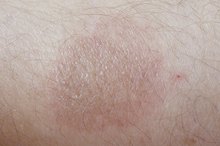How to Treat Chemical Burns From Chlorine in Pools
Chlorine is a caustic compound that is commonly used to manage the PH levels in swimming pools and water systems 1. While the chemical is safe when used properly, accidents can occur which make it a hazard to your health and necessary to treat chemical burns from chlorine in pools 1. A chemical burn from the chlorine in your pool will affect the area it came into contact first and needs to be treated immediately, preventing the skin from becoming burned worse from prolonged exposure 1. Once the skin is affected, treatment for the burn depends on the severity.
Diagnose the level of injury immediately. A diagnosis consists of the visual burn area, and the interpretive response from the chlorine chemical burn victim 1. Use a percentage of affected skin area as one of the most important factors. Large burns will almost always need immediate professional attention. If the burn is inside nose, mouth or eyes, seek medical attention. If layers of skin are broken open and tissues are visible, head to the ER immediately. Also if the person seems distraught, or is pale, feels clammy and is breathing shallow, he or she may be in shock, and you need to seek medical attention immediately.
How to Treat a Kitchen Burn
Learn More
Perform first aid on the burned area depending on the severity. Running cool water over the burned skin will help to wash away any remaining chlorine and soothe the area as clothing is removed to expose the burn and all the surround surface area of skin, even for the worse chlorine skin burns 1. Rinse the burned area thoroughly with cool to warm water for 15 to 20 minutes.
Reexamine the chlorine chemical burn 1. If the area looks like sunburn, you have a first-degree burn from chlorine in a pool 1. If the burn has blistered or has removed the top layer of skin, you have a second-degree chemical burn. Any burn that is visibly worse than just blistered skin would qualify as a third-degree burn, the type that requires immediate attention by professional caregivers to save as much epidermis as possible.
Healing Chemical Burned Skin
Learn More
Cover first-degree burns liberally with natural Aloe Vero gel. Give Ibuprofen for pain and cover small burned area with gauze. Large area first- and second-degree (one or two small blisters per six inches of skin surface) burns should remain covered to prevent infection in the remaining layers of skin under the burned area. Do not apply any Aloe Vera to broken skin. Wrap a clean cotton sheet around the burned area and leave dry for the blistered area of a second-degree burn. This will soothe the pain and draw the heat out of the burn.
Maintain a vigil over the victim until the skin has rebounded and begun to heal on its own. The burned area should scab and dry until the burned layers of skin are lost to peeling or scabbing at the blisters. Treating the burns properly with natural Aloe Vera and fresh bandages will ensure that the skin heals without scarring and the victim returns to normal as soon as possible.
Tips
Begin to monitor the victim’s body temperature from the moment the burn is noticed. Any infection in the skin will typically cause a fever. which will alert you to the need for further treatment of the chemical burn from chlorine in pools. Do not use ice or creams other than natural Aloe Vera unless recommended by a physician.
Warnings
Waiting for the proper treatment of second- and third-degree chemical burns can result in greater loss of the epidermal organ and raises the risk of complications resulting from severe chemical burns from chlorine in pools.
Related Articles
References
- Chlorine Burn Care
- American Academy of Dermatology Association. How to Treat a First-degree, Minor Burn.
- Cleveland Clinic. Burns. Updated August 31, 2017.
- Agrawal A, Raibagkar SC, Vora HJ. Friction burns: epidemiology and prevention. Ann Burns Fire Disasters. 2008;21(1):3–6.
- Shahrokhi S, Jindal K, Jeschke MG.Three Components of Education in Burn Care: Surgical Education, Inter-professional Education, and Mentorship.Burns. 2012;38(6):783-789.doi:10.1016/j.burns.2012.01.012.
Tips
- Begin to monitor the victim's body temperature from the moment the burn is noticed. Any infection in the skin will typically cause a fever. which will alert you to the need for further treatment of the chemical burn from chlorine in pools. Do not use ice or creams other than natural Aloe Vera unless recommended by a physician.
Warnings
- Waiting for the proper treatment of second- and third-degree chemical burns can result in greater loss of the epidermal organ and raises the risk of complications resulting from severe chemical burns from chlorine in pools.
Writer Bio
Francis Walsh has been working as a freelance writer since 2003. He has contributed to websites such as Shave, Autogeek and Torque & Chromeas, as well as provided content for private clients. Walsh has worked as a performance part-packer and classic car show promoter, now serving as crew chief for Nitrousfitz Racing.







